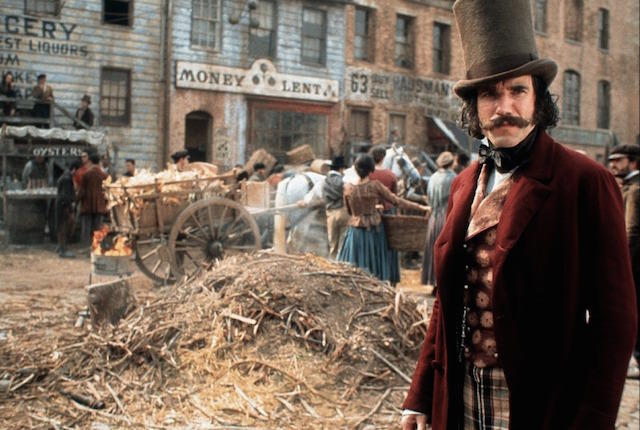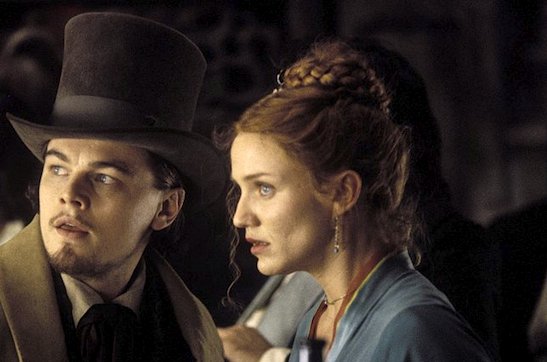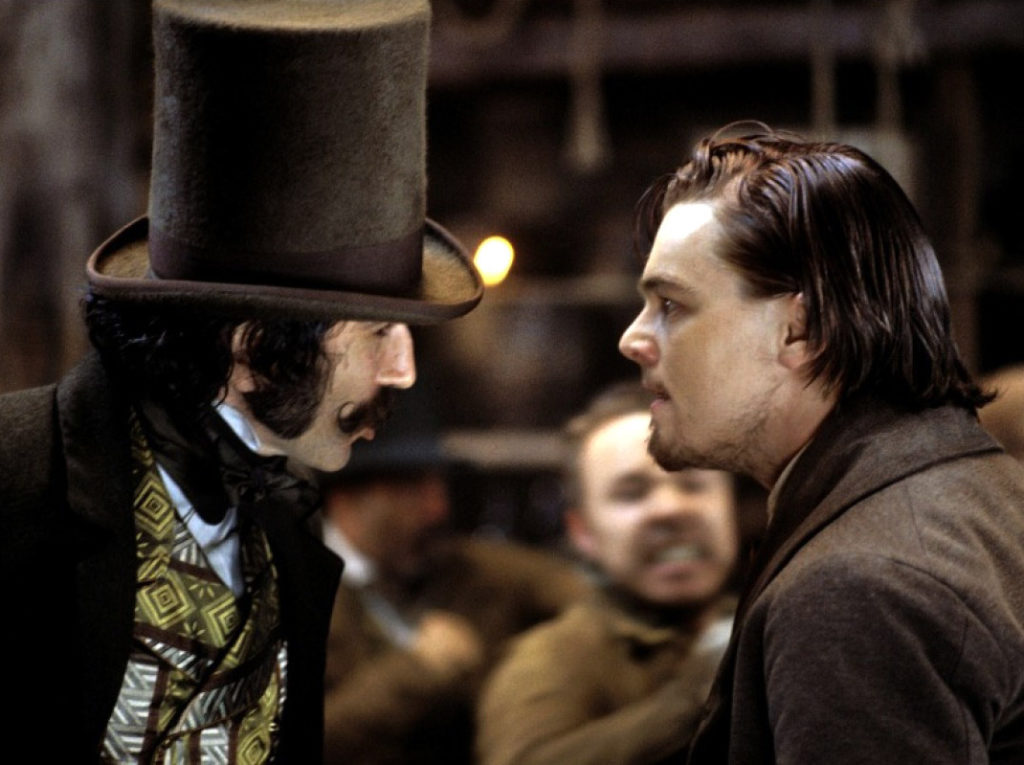Gangs of New York (2002)
CAST: Leonardo DiCaprio, Daniel Day-Lewis, Cameron Diaz, Jim Broadbent, Brendan Gleeson, John C. Reilly, Henry Thomas, Liam Neeson
REVIEW:
Martin Scorsese’s attempt at switching gears from gangster movie to historical epic, Gangs of New York is a bit of a mess, but it’s enough of a lavish, sumptuous, epically-mounted, lively, colorful mess that the grand guignol spectacle often propels us along through its formidable 3 1/2 hour runtime (it’s the kind of movie of Gone With the Wind-sized proportions that Hollywood seldom attempts to make anymore, one that would have come with an intermission halfway through) despite an excessively drawn-out and somewhat scattershot narrative and a reach that sometimes exceeds its grasp. The result is not likely to go down as one of Scorsese’s enduring classics on the level of Raging Bull or Goodfellas, but it’s a sporadically rousing and always colorful blood-soaked love letter to a forgotten corner of American history.
We open with a tremendous opening sequence set in 1846 New York City but feeling more at home on some ancient battlefield, as Irish immigrant gang the Dead Rabbits, led by “Priest” Vallon (Liam Neeson) emerges from underground caves to do battle with the so-called “Natives” of natural-born Americans led by William “Bill the Butcher” Cutting (played with gung-ho panache by Daniel Day-Lewis), who is fervently anti-immigration and anti-Irish, for mastery of the dilapidated, crime-ridden Five Points. We may be in the 1800s, but there are no guns in this medieval battle: the warring gangs duke it out with clubs, axes, swords, butcher’s tools, and anything else at their disposal. When it’s over, the snow-covered ground is stained with blood, and among the fallen is Priest Vallon, slain by The Butcher himself. Sixteen years later, Vallon’s son Amsterdam (Leonardo DiCaprio) returns to the Five Points from reform school with one thing on his mind: revenge. But there are bigger issues at play in the background. The Civil War and Lincoln’s draft are dialing up tensions and unrest in the city to the breaking point. Bill still rules over the Five Points with an iron fist, and has forged an uneasy alliance with “Boss” Tweed (Jim Broadbent), head of the notoriously corrupt Tammany Hall political machine. And complications arise when Amsterdam’s infiltration of Bill’s inner circle leads him into a love triangle of sorts with Bill’s on-again off-again mistress, pickpocket Jenny Everdeane (Cameron Diaz) and becomes conflicted when Bill takes him under his wing and treats him like a son. And this interpersonal drama plays out against the backdrop of the build-up to the draft riots of 1863, when the mob erupts and takes the city by storm.
Gangs of New York‘s greatest triumph is visual spectacle. The New York City portrayed onscreen is not strictly rooted in reality, but rather an over-the-top, heightened and stylized pastiche throwing everything but the kitchen sink into its colorful world. Along with its somewhat fictionalized versions of Bill the Butcher (loosely based on a real man named William Poole) and Boss Tweed, other historical figures drop by in cameos, such as P.T. Barnum (Roger Ashton-Griffiths), albeit all inaccurately thrown into the same time and place together (the real Bill the Butcher, for example, died a decade before the draft riots onscreen), and our colorfully-named protagonist Amsterdam Vallon is a fictional invention. On the other hand, Scorsese’s recreation of the rowdy Five Points, a crumbling shantytown loosely governed by a hodgepodge of “native” and ethnic gangs, while perhaps a little exaggerated, was praised for its historical accuracy and richly-realized production design. Dialect coach Tim Monich strove to recreate the New York accents of the 1800s as accurately as possible, using an 1892 recording of a Walt Whitman poem to help Daniel Day-Lewis develop Bill’s accent. The production was a tumultuous and lavish affair, with this thoroughly New York tale being filmed on extravagant sets in Rome, running over-budget and schedule and worrying the studio with a mammoth runtime. Scorsese had a battle of wills with producer Harvey Weinstein, who fought for a slimmer, more commercialized version. Production dragged out over three years, leaving some actors who had once been involved—including Willem Dafoe and frequent Scorsese collaborator Robert De Niro—to drop out due to scheduling conflicts, but Scorsese stuck to his guns and his own vision. Every penny of the $97 million budget is thrown back up on the screen, particularly in the sumptuous sets and climactic reenactment of the draft riots.
Where things are more shaky is narrative. Like the Five Points, Gangs of New York is sprawling and messy, trying to tackle too many themes and subplots—Tammany Hall, anti-Irish prejudice, the Amsterdam/Jenny romance, a political rivalry between Bill and Monk (Brendan Gleeson), the draft riots—which dilutes its focus on the central narrative, which when boiled down to its essence is fairly simple and straightforward and wasn’t necessary to be drawn out over a self-indulgent 3 1/2 hour runtime. There is any number of crackerjack sequences to be found within—the opening battle, the tension of an uneasy scene where Bill “playfully” terrorizes Jenny with knife-throwing tricks, Amsterdam’s assassination attempt on Bill, and various others—but also a lot of padding. Most egregiously, while the reenactment of the draft riots is rousing, the final showdown between Amsterdam and Bill is anti-climactic. This is the kind of movie that seems to be inevitably building toward a climactic mano-a-mano, then leaves us feeling cheated. This is a case of the journey being more interesting than the destination.
 Standing head-and-shoulders above the rest of the cast (often physically as well as with the strength of his performance) is Daniel Day-Lewis, whose Bill the Butcher is one of the great colorful film characters of recent years, cutting an unmistakable figure with his towering top hat, handlebar mustache, and glass eye with an American eagle emblem for a pupil (he’s hardly recognizable as the same person, either in voice, appearance, or manner from his hunky hero in The Last of the Mohicans). Yet even as he devours scenery with lip-smacking gusto, Day-Lewis does not make Bill a one-dimensional caricature or a consistently straightforward villain. In fact, the most moving scene in the movie is a quiet one where Bill has a rare subdued moment of emotional openness, confiding to Amsterdam that Priest Vallon was “the only man I ever killed worth remembering” and laments that Amsterdam is the son he never had. He treats Jenny decently—at least until suspecting her of betrayal—and abides by his own rough but strict sense of honor. At the same time, he can veer from waxing philosophical to occasional bursts of savagery. For an actor who emerged from self-proclaimed retirement—and has returned to acting sporadically since—Day-Lewis is obviously fully invested in his part, and it shows; this is the kind of electrifying performance that audiences can’t take their eyes off of. Bill is darkly humorous, frightening, and almost strangely sympathetic, sometimes all in the same scene; his Oscar nomination appears to be well-deserved.
Standing head-and-shoulders above the rest of the cast (often physically as well as with the strength of his performance) is Daniel Day-Lewis, whose Bill the Butcher is one of the great colorful film characters of recent years, cutting an unmistakable figure with his towering top hat, handlebar mustache, and glass eye with an American eagle emblem for a pupil (he’s hardly recognizable as the same person, either in voice, appearance, or manner from his hunky hero in The Last of the Mohicans). Yet even as he devours scenery with lip-smacking gusto, Day-Lewis does not make Bill a one-dimensional caricature or a consistently straightforward villain. In fact, the most moving scene in the movie is a quiet one where Bill has a rare subdued moment of emotional openness, confiding to Amsterdam that Priest Vallon was “the only man I ever killed worth remembering” and laments that Amsterdam is the son he never had. He treats Jenny decently—at least until suspecting her of betrayal—and abides by his own rough but strict sense of honor. At the same time, he can veer from waxing philosophical to occasional bursts of savagery. For an actor who emerged from self-proclaimed retirement—and has returned to acting sporadically since—Day-Lewis is obviously fully invested in his part, and it shows; this is the kind of electrifying performance that audiences can’t take their eyes off of. Bill is darkly humorous, frightening, and almost strangely sympathetic, sometimes all in the same scene; his Oscar nomination appears to be well-deserved.
 If there’s a downside to Day-Lewis’ performance, it’s that this kind of show-stealing scenery-chewing inevitably leaves the rest of the cast in his shadow. Leonardo DiCaprio is navigating that awkward stage between growing out of his teen heartthrob Titanic days and making the transition into a serious adult actor, but his work is uneven. For the most part, he’s adequate, but there’s times when DiCaprio doesn’t seem to have quite a firm handle on his character, nor does he have anywhere near Day-Lewis’ magnetic screen presence, leaving Amsterdam a rather bland and generic protagonist who even in his best moments is never as interesting as Bill. Ditto for Cameron Diaz, although she and DiCaprio generate a little erotic heat in an oddly tender moment where they compare scars that’s kind of like the scene in Jaws, only plus sexual tension. Apart from Day-Lewis, the supporting cast is more colorful than the leads, including Jim Broadbent’s flamboyantly corrupt Boss Tweed, Brendan Gleeson as the ambiguously-motivated hired muscle Monk, John C. Reilly as crooked cop Happy Jack, Henry Thomas as Amsterdam’s friend Johnny, and Liam Neeson in an all-too-short stint as Priest Vallon.
If there’s a downside to Day-Lewis’ performance, it’s that this kind of show-stealing scenery-chewing inevitably leaves the rest of the cast in his shadow. Leonardo DiCaprio is navigating that awkward stage between growing out of his teen heartthrob Titanic days and making the transition into a serious adult actor, but his work is uneven. For the most part, he’s adequate, but there’s times when DiCaprio doesn’t seem to have quite a firm handle on his character, nor does he have anywhere near Day-Lewis’ magnetic screen presence, leaving Amsterdam a rather bland and generic protagonist who even in his best moments is never as interesting as Bill. Ditto for Cameron Diaz, although she and DiCaprio generate a little erotic heat in an oddly tender moment where they compare scars that’s kind of like the scene in Jaws, only plus sexual tension. Apart from Day-Lewis, the supporting cast is more colorful than the leads, including Jim Broadbent’s flamboyantly corrupt Boss Tweed, Brendan Gleeson as the ambiguously-motivated hired muscle Monk, John C. Reilly as crooked cop Happy Jack, Henry Thomas as Amsterdam’s friend Johnny, and Liam Neeson in an all-too-short stint as Priest Vallon.
At the bottom line, Gangs of New York is less than the sum of its parts, though some of those parts are tremendous, and the film largely coasts over its own uncertain path with the power of its lively flamboyance. The runtime is excessive, the narrative is overstuffed and unwieldy, and the conclusion is disappointingly anti-climactic, but Day-Lewis’ performance and the sheer epic spectacle make it worth at least a look.
* * *
